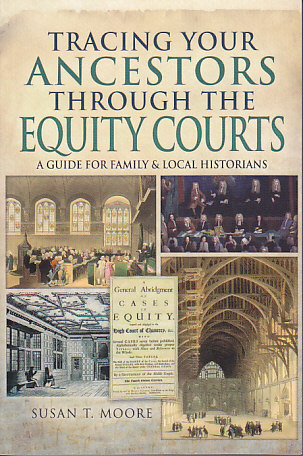
Tracing Your Ancestors Through the Equity Courts: A Guide for Family & Local Historians. By Susan T. Moore. Published by Pen & Sword Family History, 47 Church Street, Barnsley, South Yorkshire S70 2AS, UK www.pen-and-sword.co.uk. £14.99. US Distributor: CasemateIPM 1950 Lawrence Road, Havertown PA 19083. www.casemateipm.com. $26.95. 2017. 211 pp. Illustrations, index. Softcover.
These voluminous records of the equity courts contain a wealth of family details, both in terms of relationships and character. Was your ancestor kind, compassionate, giving or rather cruel, belligerent and miserly? What was their day-to-day life like? The equity court records often reveal the answers to questions like these. They are also valuable for the local historian seeking information on the social networks, land ownership and the economics of a given locality.
The numerous courts of equity include: Chancery; Star Chamber; Requests; Exchequer; Duchy Chamber for Duchy of Lancaster; Palatinate of Durham; Exchequer of Chester; and Welsh Courts of Equity. “The principal difference between the common law courts and the equity courts was that the equity courts were based on what is right morally, whereas the common law courts relied on the law” (p.3). From the researcher’s perspective, the principal difference is that the equity court records are all in one location at The National Archives (except the Welsh courts); and are in English rather than Latin as for criminal records until 1733.
The Court of Chancery is the most voluminous record collection originating in 1377 and running through 1876. It is from this court that the bulk of the examples originate. Lots of cases here refer to the possession or the occupation of land, rather than legal ownership as would be in under common law, because so much land was held in trust or mortgaged. The other equity courts are explained and illustrated to a lessor extent. Furthermore, the book provides additional background on items that will be useful to the researcher, such as paleography, understanding of wills, deeds and legal terms. It also provides a broad overview of the types of documents to be found and where they come in the process, but these are more fully described later.
The second chapter answers the question, “Why look at the courts of equity?” It provides examples of: the type of information to be found in bills and answers, explains relationships in detail, often across multiple generations, tells how and why women and children can be parties to a case, quotes other records such as wills, deeds, leases, and mortgages, and details where and how a family may have lived even in terms of details of the house or land, and finally, details business transactions. The records can also be of value in proving immigrant origins or business ties.
Chapter three starts by examining the paleography of records. and continues by describing what the various types of documents are likely to contain. In this context, it covers records such as: pleadings, bills and answers; interrogatories and depositions; decrees and orders; Chancery masters’ reports; Chancery masters’ exhibitions; masters’ documents; cause books; affidavits; petitions; and account books. The chapter concludes by looking at the key phrases that will help identify specific types of documents.
Chapter four addressing indexes is important as so much has changed and continues to change regarding what is online, in print, or only available through calendars at TNA. There are tables for each of the courts explaining what indexes are available where, and in some cases digital images of the records themselves. The up-to-date tables alone make the edition worth buying, even for researchers who may have an earlier edition.
Throughout these first four chapters, extensive use is made of transcripts and case summaries to highlight the value of the records. Chapter five uses sample cases to go into more depth, illustrating the more common reasons for using the records. , Even, so these samples still only provide a snapshot of the detail that can be found for: loans and debts; probate disputes; marriage settlements and annuities; management of property from afar; merchants and mariners; trades and tradesmen; American connections; field names; and former monastic lands. The final chapter is an interesting though voluminous case study of the Lefroy family and its connections with Jane Austen’s family. The book concludes with a glossary and bibliography.
Chancery records are an underutilized record group which can be very valuable for reconstructing families and their characters. This book provides a clear guide into how to access and use these records. It is thus highly recommended for any English/Welsh researcher and all types of genealogical collections.